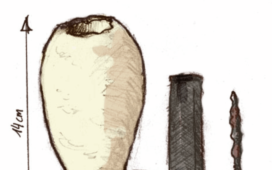In previous centuries, unless you were a member of the nobility, a wealthy religious order, or a merchant guild, your chances of spending any significant amount of time with a Medieval tapestry were slim. Though “much production was relatively coarse, intended for decorative purposes,” writes the Metropolitan Museum of Art, the tapestry still commanded high prices, just as it commanded respect for its owner. And as other decorative arts of the time preserved historical memory—or certain political versions of it, at least—tapestry designs might embody “celebratory or propagandistic themes” in their weft and warp.
“Enriched with silk and gilt metallic thread,” writes the Met, “such tapestries were a central component of the ostentatious magnificence used by powerful secular and religious rulers to broadcast their wealth and might.” Such is one of the most famous of these works, the Bayeux Tapestry, which commemorates the 1066 victory of William the Conqueror at the Battle of Hastings. The famous wall hanging, housed at the Bayeux Museum in Normandy, was “probably commissioned in the 1070s” by Bishop Odo of Bayeux, William’s half-brother, making it a very early example of the form. So the site of a Victorian-era replica writes, and yet “nothing known is certain about the tapestry’s origins.” (The first written record of it dates from 1476.)
While the Bayeux Tapestry may have been inaccessible to most people for however many centuries it has existed, you can now stand before it in its home of Bayeux, or see the very convincing replica at Britain’s Reading Museum. (You’ll note in both cases that the Bayeux tapestry is not, in fact, a tapestry, woven on a loom, but a painstaking, hand-stitched embroidery.) Or, rather than traveling, you can watch the video above, an animated rendition of the tapestry’s story by filmmaker David Newton and sound designer Marc Sylvan.
During the years 1064 to the fateful 1066, a fierce rivalry took shape as the ailing King Edward the Confessor’s advisor Harold Godwinson and William the Conqueror vied for the crown. Once Edward died in 1066, Harold seized the throne, prompting William to invade and defeat him at the Battle of Hastings. The Tapestry gives us a graphic history of this bloody contest, “a story,” writes the Bayeux Museum, “broadly in keeping with the accounts of authors of the 11th century.” “The Tapestry’s depiction of the Battle of Hastings,” historian Robert Bartlett tells us, “is the fullest pictorial record of a medieval battle in existence”—and the animation above makes it come alive with sound and movement.
Note: The Animated Bayeux Tapestry above was originally created as a student project. David Newton provided the animation, and Marc Sylvan created the original music and sound effects. Enjoy!
Related Content:
Construct Your Own Bayeux Tapestry with This Free Online App
How the Ornate Tapestries from the Age of Louis XIV Were Made (and Are Still Made Today)
Josh Jones is a writer and musician based in Durham, NC. Follow him at @jdmagness















